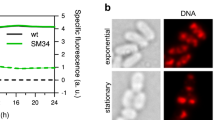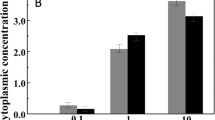Abstract
EXTREMELY halophilic bacteria, such as Halobacterium cutirubrum, grow only in high NaCl concentrations (2.5–5 M) and have very high (5 M or higher) internal concentrations of salts, mainly KCl1,2. The ribosomes and protein-synthesising systems of these organisms seem especially adapted to function in such concentrations3. In contrast, moderately halophilic bacteria, such as Vibrio costicola, grow over a much wider range of NaCl concentrations (at least 0.5–3.5 M)4. In V. costicola, though not necessarily in all moderate halophiles, the cell-associated monovalent cations are at least as concentrated as those of the external medium. For example, cells growing exponentially in medium containing 1 M NaCl and 0.008 M KC1 can have internal Na+, K+, and NH4+ concentrations of about 0.6, 0.7 and 0.4 M respectively, as well as 40 mM Mg2+ (ref. 5 and our unpublished results). Ribosomes from V. costicola differ from those of both extremely halophilic and non-halophilic bacteria in their ability to maintain a ‘standard’ sedimentation pattern (30, 50 and 70S) over a wide range of salt concentrations. This pattern is not changed by the NaCl concentration in which the cells are grown6. Such properties, however, do not really tell us how well the ribosomes function at different salt concentrations. Studies of in vitro protein synthesis, reported here, suggest that ribosomes may function at much lower salt concentrations than measurements of total cell-associated ions indicated to be present in the cell.
This is a preview of subscription content, access via your institution
Access options
Subscribe to this journal
Receive 51 print issues and online access
$199.00 per year
only $3.90 per issue
Buy this article
- Purchase on Springer Link
- Instant access to full article PDF
Prices may be subject to local taxes which are calculated during checkout
Similar content being viewed by others
References
Kushner, D. J. Adv. Appl. Microbiol. 10, 73 (1968).
Brown, A. D. Bact. Rev. 40, 803(1976).
Bayley, S. T. in Extreme Environments: Mechanism of Microbial Adaptation(ed. Heinrich, M. R.) 119 (Academic, New York, 1976).
Forsyth, M. P. & Kushner, D. J. Can. J. Microbiol. 16, 253 (1970).
Shindler, D. B. Wydro, R. M. & Kushner, D. J. J. Bact. 130 (1977).
Wydro, R., Kogut, M. & Kushner, D. J. FEBS Lett. 60, 210 (1975).
Pestka, S., Scolnick, E. M. & Heck, B. H. Analyt. Biochem. 28, 376 (1969).
Lanyi, J. K. Bact. Rev. 38, 272 (1974).
Beveridge, T. J. & Murray, R. G. E. J. Bact. 127, 1502 (1976).
Author information
Authors and Affiliations
Rights and permissions
About this article
Cite this article
WYDRO, R., MADIRA, W., HIRAMATSU, T. et al. Salt-sensitive in vitro protein synthesis by a moderately halophilic bacterium. Nature 269, 824–825 (1977). https://doi.org/10.1038/269824a0
Received:
Accepted:
Issue Date:
DOI: https://doi.org/10.1038/269824a0
This article is cited by
Comments
By submitting a comment you agree to abide by our Terms and Community Guidelines. If you find something abusive or that does not comply with our terms or guidelines please flag it as inappropriate.



